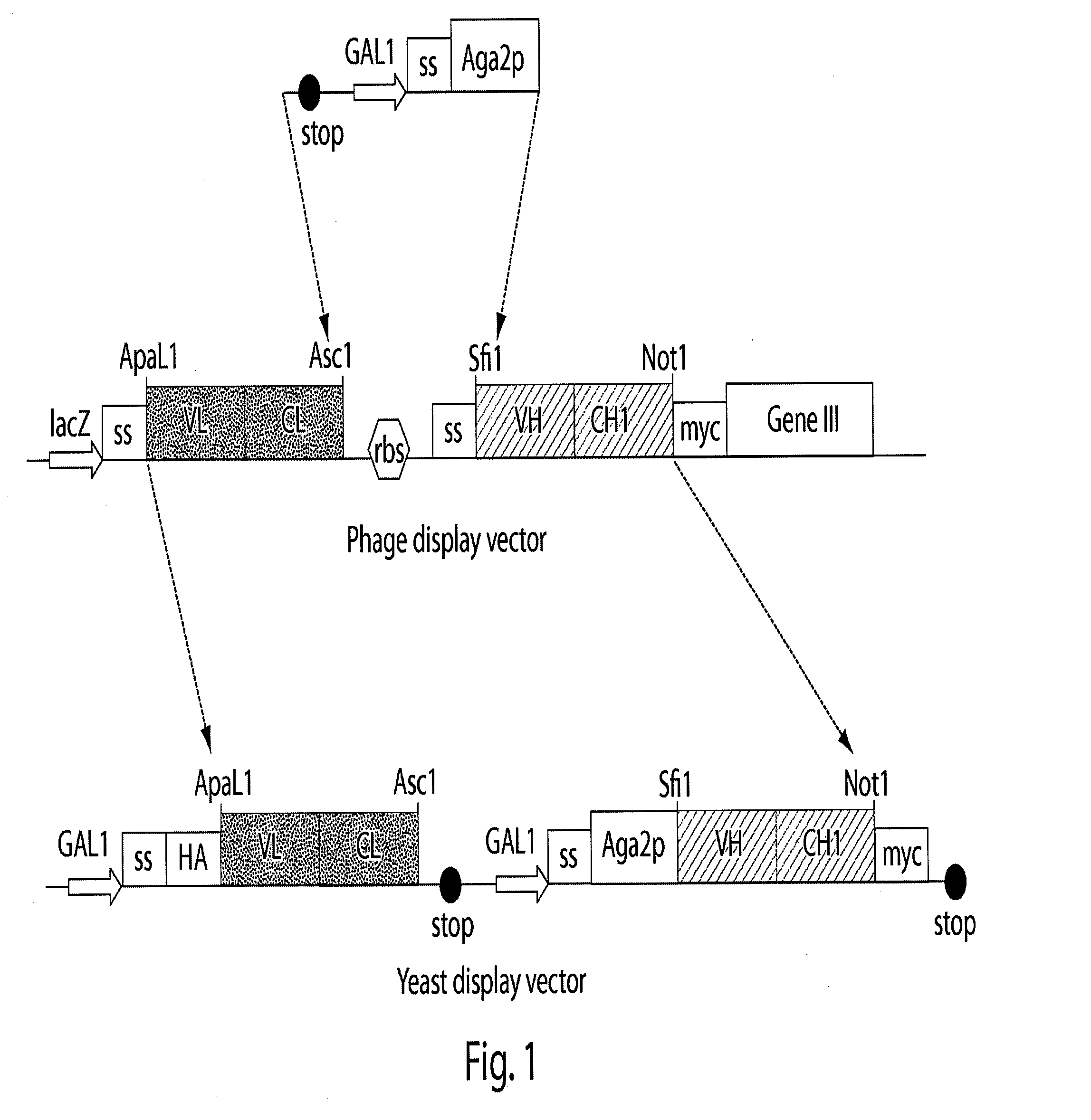Multi-chain eukaryotic display vectors and uses thereof
a technology of eukaryotic display vectors and multi-chain eukaryotics, which is applied in the field of multi-chain eukaryotic display vectors, can solve the problems of obstructed the advancement of biological tools and techniques useful, and none of these processes can be accomplished by bacteriophage or prokaryotic cell processes
- Summary
- Abstract
- Description
- Claims
- Application Information
AI Technical Summary
Benefits of technology
Problems solved by technology
Method used
Image
Examples
example 1
Construction of a Multi-Chain Eukaryotic Display Vector: pTQ3
[0168]The materials and techniques described above and incorporated by reference were used to construct a multi-chain eukaryotic display vector; specifically a yeast display vector effective in a host yeast cell transformed with the vector. The vector is useful for expressing, transporting, assembling and displaying a biologically active multi-chain polypeptide (e.g., an Ig Fab) on the surface of the host yeast cell.
[0169]In this example, a commercially available vector, pYD1 (InVitrogen, Carlsbad, Calif.), a 5.0 kb expression vector designed for expression, secretion, and display of a single chain protein on the surface of S. cerevisiae cells, was used as the starting eukaryotic expression vector template. pYD1 includes: an aga2 gene encoding one of the subunits of the α-agglutinin receptor; a GAL1 promoter for regulated expression of an Aga2 / polypeptide fusion; an HA epitope tag for detection of the displayed protein; a ...
example 2
Phage Display-Eukaryotic Transfer and Eukaryotic Host Cell Expression of Multi-chain Fab Polypeptides Specific for Streptavidin, Mucin-1 and Cytotoxic T-Lymphocyte Associated Antigen 4
[0180]Different phage display Fabs were transferred from the phage display vector to a multi-chain eukaryotic display vector to demonstrate of the utility of the phage display-eukaryotic display transfer system, and the ability of the multi-chain eukaryotic vector of the present invention to express a multi-chain polypeptide. The vector was then inserted into a eukaryotic host cell, and the transformed host cell grown under conditions suitable for expression of the Fabs.
[0181]Anti-streptavidin Fab antibodies, F2, A12, and 4C8 were each cloned from a large naive human Fab library (de Haard, H. et al., 1999) into the multi-chain yeast display vector pTQ3 constructed in Example 1 as a paired light chain (VLCL) and heavy chain (VHCH1). Additionally, an anti-mucin Fab antibody, PHI, was cloned from the same...
example 3
Functional Surface Display of a Multi-Chain Polypeptide on a Eukaryotic Host Cell
[0187]As a demonstration of the ability of the multi-chain eukaryotic vector of the present invention to express, assemble and properly display a biologically active multi-chain polypeptide on the surface of a eukaryotic host cell, a multi-chain eukaryotic display vector was inserted into a eukaryotic host cell and the transformed host coil was grown under conditions suitable for expression and display of the Fab on the surface of the host cell.
[0188]Yeast clones EBY100 pTQ3-F2, EBY100 pTQ3-PH1, EBY100 pTQ3-E7, EBY100 pTQ3-E8, EBY100 pTQ3-A9 and EBY100 pTQ3-A11 were prepared, cultured, and induced for antibody expression as described in Example 2 above. Three 0.2 mL aliquots of yeast cells having an OD600 of 1.0 were removed prior to induction with galactose, as the T0 point.
[0189]After inducing expression with galactose (Example 2), three additional 0.2 mL aliquots of cells having an OD600 of 1.0 were ...
PUM
| Property | Measurement | Unit |
|---|---|---|
| volume | aaaaa | aaaaa |
| temperature | aaaaa | aaaaa |
| affinity | aaaaa | aaaaa |
Abstract
Description
Claims
Application Information
 Login to View More
Login to View More - R&D
- Intellectual Property
- Life Sciences
- Materials
- Tech Scout
- Unparalleled Data Quality
- Higher Quality Content
- 60% Fewer Hallucinations
Browse by: Latest US Patents, China's latest patents, Technical Efficacy Thesaurus, Application Domain, Technology Topic, Popular Technical Reports.
© 2025 PatSnap. All rights reserved.Legal|Privacy policy|Modern Slavery Act Transparency Statement|Sitemap|About US| Contact US: help@patsnap.com



